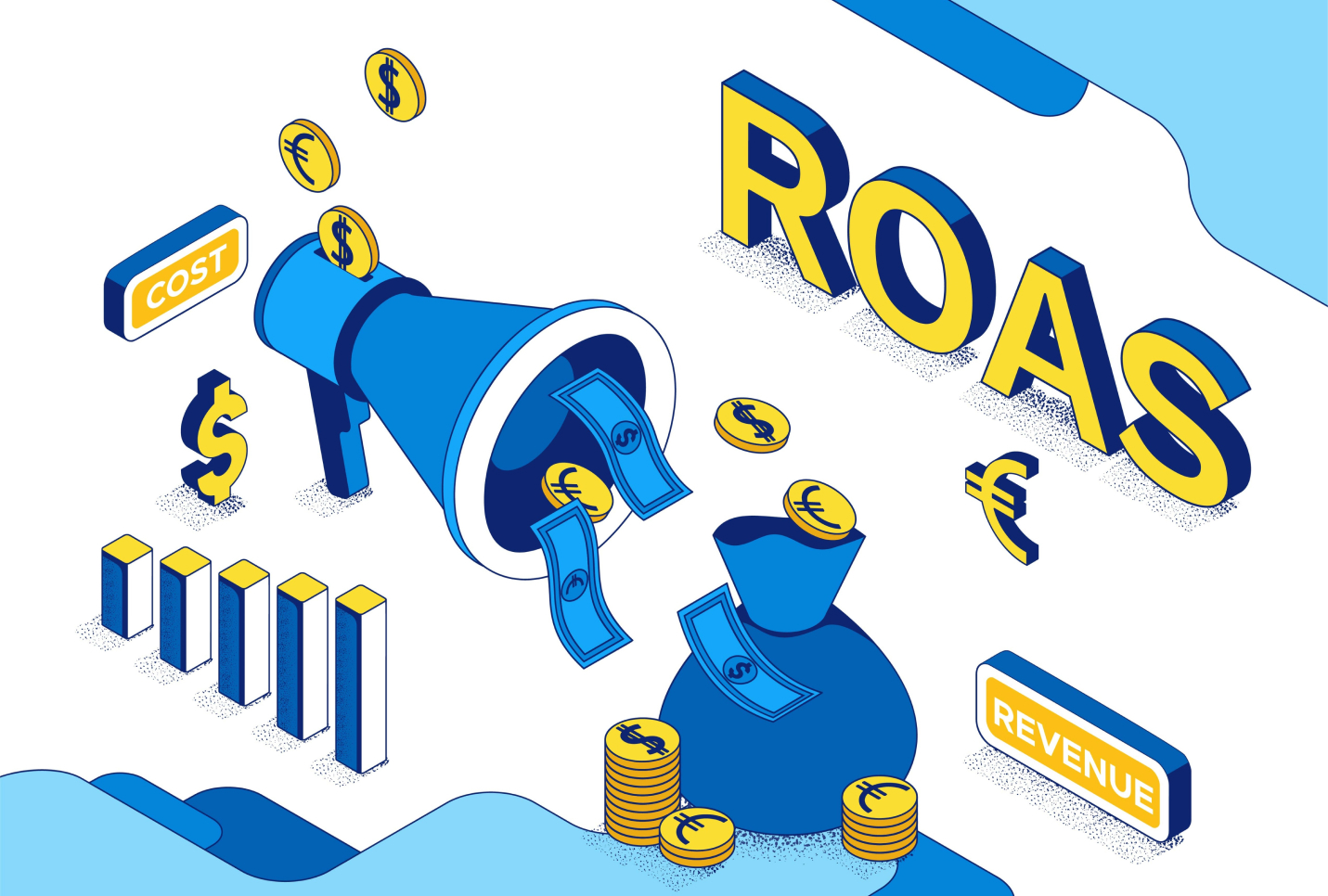How To Calculate Return on Ad Spend [Understanding ROAS]

In today's fast-paced, digital-centric world, where businesses compete fiercely for customer attention, advertising spending has reached new heights. The traditional forms of measuring advertising success have evolved, and the ability to calculate an accurate return on investment (ROI) is no longer a choice but a necessity, especially in the realm of digital marketing.
Understanding and maximizing ROI is not just about the numbers; it's about aligning advertising strategies with core business objectives. That's where the concept of return on ad spend (ROAS) comes into play, a critical measure that offers profound insights into the effectiveness of advertising campaigns across various digital platforms.
ROAS transcends mere data. It's a nuanced approach that considers various facets of advertising, from the selection of platforms to creative messaging and targeting strategies. By effectively calculating ROAS, businesses can pinpoint exactly which parts of their advertising are most effective, optimizing for more efficient ad spending.
Why Measure ROAS?
Understanding and accurately calculating return on ad spend (ROAS) has become a critical necessity for the contemporary marketer. The ROAS metric provides a quantitative measure of the effectiveness of advertising campaigns, offering a more refined look into the advertising process.
By determining the precise amount of revenue generated for each dollar spent on advertising, marketers can gauge the performance across various channels like Google Ads, Facebook Ads,Instagram, and others.
Assessing ROAS allows for targeted investments, offering insights into what is working and what requires optimization. It's a powerful tool that aids with decision-making, ensuring that the marketing budget is used to its fullest potential.
Key Performance Indicator in Marketing
As a key performance indicator (KPI) in marketing, ROAS carries significant weight in determining the profit margins and overall net profit of a business. It's not just about recognizing a positive return; it's about understanding how advertisements resonate with the audience and lead to conversions.
Tracking ROAS can help guide budget allocation, allowing businesses to channel investments into marketing efforts that yield the most substantial returns, ensuring that the campaign performance operates at its highest efficiency.
Analyzing ROAS in conjunction with other metrics offers a multi-dimensional view of campaign performance, helping to tailor strategies that are more receptive to market trends and customer behavior.
Alignment With Business Objectives
An accurate and frequently monitored ROAS aligns with the broader business objectives. By precisely identifying the profitability of advertising efforts, eCommerce businesses, service providers, and other sectors can match their marketing strategies with overarching organizational goals.
The outcome is a cohesive approach that effectively maximizes the total ad spend, promoting both short-term gains and long-term growth. It serves as a strategic compass that ensures that marketing efforts are not isolated from the broader business landscape but integral to organizational success.
Relationship With Other Marketing Metrics
ROAS doesn't stand alone, as it’s closely linked with several important metrics:
• Click-Through Rate (CTR): This measures the number of clicks received per impression, influencing ROAS by indicating the advertisement's effectiveness in encouraging viewers to take action.
• Conversion Rate: Reflecting the percentage of visitors that turn into customers, this informs the success of the ad in generating sales.
• Conversion Value: Represents the monetary value attributed to each conversion, directly influencing ROAS.
• Cost Per Click (CPC):This measures how much each click costs the advertiser, affecting the overall ROI.
• Customer Lifetime Value (CLV): Understanding this metric helps gauge the long-term value of a customer, providing context to immediate returns.
How To Measure Advertising Revenue
Measuring ad revenue accurately is vital for precise ROAS calculation and forms the foundation for a thorough understanding of a campaign's impact. This process can be detailed and complex, involving several stages and considerations:
Attribution Models
Attribution models are essential frameworks for attributing credit for a conversion to different touchpoints in a customer's journey. They offer insights into how different elements of an advertising campaign contribute to its success.
Examples include:
• Single Attribution: This model, while simple, allocates all credit to the last ad or landing page clicked, typically used in PPC (pay-per-click) campaigns. It's straightforward, but it often fails to recognize previous interactions, thus limiting the understanding of a customer's entire journey with the brand.
• Multi-touch attribution: This is a more comprehensive and nuanced approach, considering multiple touchpoints in the conversion path and distributing credit among them. Types of multi-touch attribution include:
• First-Click Attribution: Credits the first interaction a customer had with the brand.
• Linear Attribution: Distributes credit equally across all touchpoints.
• Time Decay Attribution: Assigns more credit to the touchpoints closer to conversion.
• Position-Based Attribution: This model assigns credit based on the importance of the touchpoint in the conversion process.
• Other Types of Attribution: Marketers may also devise custom attribution models that best fit their unique needs, customer behavior, and business objectives.
It's important to note that the choice of an attribution model is not a one-size-fits-all decision. It should align with the specific campaign goals, customer behaviors, and business strategy.
Utilizing tools and expertise to analyze and interpret the data within these frameworks can lead to more successful and efficient digital advertising efforts. Testing different models and evaluating them against actual results can also guide the way to the most suitable attribution model for any given situation.
Tools and Platforms for Accurate Measurement
Measuring advertising revenue demands precision, and the selection of the right tools and platforms is crucial.
Tools like Google Analytics, Adobe Analytics, and custom solutions offer capabilities for tracking various metrics:
• Google Analytics: It offers a broad range of tracking features, including user behavior, conversion paths, and e-commerce tracking. It can be integrated with platforms like Google Ads to provide a comprehensive picture of ad performance. Real-time reporting and customizable dashboards enhance the analysis.
• Adobe Analytics: This platform is renowned for more advanced analytics capabilities. Beyond standard tracking, it can delve into customer segmentation, various channels, and personalized reporting. It's suitable for complex campaigns that need more profound insights.
• Custom Solutions: For those with highly specific needs or unique business models, custom-built tools might be the answer. These can be tailored to the particular requirements of a campaign or business, offering flexibility and precision that off-the-shelf solutions might not provide.
How To Calculate ROAS
ROAS is more than a mere metric; it's a crucial barometer for assessing the success of marketing campaigns. This tangible numerical figure translates abstract marketing efforts into quantifiable success, forming the backbone of advertising strategy. Understanding this calculation helps marketers allocate resources wisely, make strategic decisions that drive revenue, and shape future advertising endeavors.
Here's how to calculate it:
The ROAS Formula
The formula to calculate ROAS is relatively simple but crucial for determining the success of specific ad campaigns:
ROAS = Total Revenue from Ad Campaign/Cost of Ad Campaign
This formula's brilliance lies in its simplicity and ability to capture the essence of what advertisers aim to achieve: maximum revenue from optimal spending.
Step-by-Step Guide
Here's a step-by-step guide to unpacking this formula:
1. Gathering cost data: Include all advertising costs related to the advertisement, such as ad placement, creative expenses, Facebook Ads, Google Ads fees, and even overheads like agency fees or software tools. Considering all the associated costs ensures that the resulting ROAS is comprehensive and truly reflective of the campaign's efficiency. Overlooking any aspect could lead to a skewed perception of success.
2. Tracking revenue: Measure the direct revenue generated from the ad campaign, focusing on conversion value and the amount of money earned. This involves close coordination with sales, e-commerce tracking systems, and customer relationship management platforms to ensure that all transactions are captured and attributed correctly. Even the indirect revenue streams, like customer referrals or follow-up sales, need to be considered to have a complete picture.
3. Applying the formula: Divide the total revenue by the cost to calculate ROAS. This straightforward calculation yields a ratio that encapsulates the campaign's financial success. But this number needs to be understood in context and seen in conjunction with other metrics for a complete understanding.
Interpretation of Results
Understanding whether you have a high ROAS or low ROAS is essential.
Generally, a ROAS of 4:1 is considered solid, meaning $4 in revenue for every $1 spent. However, this isn't a one-size-fits-all figure. This benchmark can vary widely depending on the industry, product lifecycle, competition, and other unique factors.
That said, different industries and channels may have unique benchmarks. Adjusting expectations based on these specific contexts is vital. What might be an excellent ROAS in one industry might be subpar in another. For instance, highly competitive sectors might see a lower ROAS, while niche markets might achieve a higher ratio.
How To Improve ROAS
Improving ROAS means enhancing messaging, creative optimization, and embracing an iterative approach to advertising strategy.
Here's a more detailed exploration:
Targeting and Segmentation
Refining targeting and segmentation can lead to more relevant ads and brand awareness, thus improving ROAS. Utilizing data-driven insights to reach the right audience means less waste on irrelevant impressions and more concentration on potential customers, optimizing ad performance and contributing to high ROAS.
Creative Optimization
Ad creative plays a crucial role in engagement. A/B testing and optimizing creative elements such as headlines, images, or calls to action can lead to more effective ads, a higher ROAS, and better alignment with target ROAS goals. The process involves continuous experimentation, learning, and adapting to audience preferences.
Bid Management
Efficient bid management, such as utilizing automated bidding strategies on platforms like Google Ads, can help manage costs while maximizing exposure. By employing intelligent algorithms that understand market dynamics, advertisers can achieve the desired ad placements at optimal costs, leading to improved ROAS.
Performance Monitoring
Continuous performance monitoring of ad accounts and tweaking ad performance is vital to maintaining or improving ROAS. Real-time analytics and insights enable quick adjustments and optimizations, keeping campaigns agile and responsive to changing conditions.
The Bottom Line
ROAS is not just a number but a profound insight into the effectiveness of advertising campaigns. Its alignment with key performance indicators and business objectives and its relationship with other vital marketing metrics makes it indispensable.
Calculating and optimizing ROAS is a continuous process. Gathering accurate data, applying the right attribution models, and continuous monitoring and optimization are essential.
Embracing ROAS as a core metric in advertising strategy is a call to action for all marketers. Its proper calculation, interpretation, and utilization can guide more profitable and aligned marketing strategies.
By implementing the insights and strategies outlined in this guide, businesses and marketers can leverage ROAS to create more impactful and efficient advertising campaigns, leading to sustained growth and success.
If you want to learn more about how to improve your marketing strategies, check out some of our additional resources or schedule a consultation with us to discuss specific details about your digital marketing campaign. Together, we can help “GR0” your ROAS to new heights!
Sources:
Digital Advertising Spending Worldwide 2021-2026 | Statista
Return on Investment (ROI): How to Calculate It and What It Means | Investopedia
What Is Click-Through Rate & Why CTR Is Important | Search Engine Journal
Key Performance Indicator (KPI): Definition, Types, and Examples | Investopedia
What Is Conversion Rate & How Do You Calculate It | Search Engine Journal
A Refresher on A/B Testing | Harvard Business Review
Conversion Value: What it is, How it Works, Example | Investopedia
What Is Cost Per Click (CPC)? | Search Engine Journal
Market Segmentation and Targeting | Corporate Finance Institute
What Is Customer Lifetime Value (CLV) | Forbes Advisor
A Comprehensive Guide To Marketing Attribution Models | Search Engine Journal
What Is Google Analytics and How Does it Work? | Tech Target
Table of Contents
In today's fast-paced, digital-centric world, where businesses compete fiercely for customer attention, advertising spending has reached new heights. The traditional forms of measuring advertising success have evolved, and the ability to calculate an accurate return on investment (ROI) is no longer a choice but a necessity, especially in the realm of digital marketing.
Understanding and maximizing ROI is not just about the numbers; it's about aligning advertising strategies with core business objectives. That's where the concept of return on ad spend (ROAS) comes into play, a critical measure that offers profound insights into the effectiveness of advertising campaigns across various digital platforms.
ROAS transcends mere data. It's a nuanced approach that considers various facets of advertising, from the selection of platforms to creative messaging and targeting strategies. By effectively calculating ROAS, businesses can pinpoint exactly which parts of their advertising are most effective, optimizing for more efficient ad spending.
Why Measure ROAS?
Understanding and accurately calculating return on ad spend (ROAS) has become a critical necessity for the contemporary marketer. The ROAS metric provides a quantitative measure of the effectiveness of advertising campaigns, offering a more refined look into the advertising process.
By determining the precise amount of revenue generated for each dollar spent on advertising, marketers can gauge the performance across various channels like Google Ads, Facebook Ads,Instagram, and others.
Assessing ROAS allows for targeted investments, offering insights into what is working and what requires optimization. It's a powerful tool that aids with decision-making, ensuring that the marketing budget is used to its fullest potential.
Key Performance Indicator in Marketing
As a key performance indicator (KPI) in marketing, ROAS carries significant weight in determining the profit margins and overall net profit of a business. It's not just about recognizing a positive return; it's about understanding how advertisements resonate with the audience and lead to conversions.
Tracking ROAS can help guide budget allocation, allowing businesses to channel investments into marketing efforts that yield the most substantial returns, ensuring that the campaign performance operates at its highest efficiency.
Analyzing ROAS in conjunction with other metrics offers a multi-dimensional view of campaign performance, helping to tailor strategies that are more receptive to market trends and customer behavior.
Alignment With Business Objectives
An accurate and frequently monitored ROAS aligns with the broader business objectives. By precisely identifying the profitability of advertising efforts, eCommerce businesses, service providers, and other sectors can match their marketing strategies with overarching organizational goals.
The outcome is a cohesive approach that effectively maximizes the total ad spend, promoting both short-term gains and long-term growth. It serves as a strategic compass that ensures that marketing efforts are not isolated from the broader business landscape but integral to organizational success.
Relationship With Other Marketing Metrics
ROAS doesn't stand alone, as it’s closely linked with several important metrics:
• Click-Through Rate (CTR): This measures the number of clicks received per impression, influencing ROAS by indicating the advertisement's effectiveness in encouraging viewers to take action.
• Conversion Rate: Reflecting the percentage of visitors that turn into customers, this informs the success of the ad in generating sales.
• Conversion Value: Represents the monetary value attributed to each conversion, directly influencing ROAS.
• Cost Per Click (CPC):This measures how much each click costs the advertiser, affecting the overall ROI.
• Customer Lifetime Value (CLV): Understanding this metric helps gauge the long-term value of a customer, providing context to immediate returns.
How To Measure Advertising Revenue
Measuring ad revenue accurately is vital for precise ROAS calculation and forms the foundation for a thorough understanding of a campaign's impact. This process can be detailed and complex, involving several stages and considerations:
Attribution Models
Attribution models are essential frameworks for attributing credit for a conversion to different touchpoints in a customer's journey. They offer insights into how different elements of an advertising campaign contribute to its success.
Examples include:
• Single Attribution: This model, while simple, allocates all credit to the last ad or landing page clicked, typically used in PPC (pay-per-click) campaigns. It's straightforward, but it often fails to recognize previous interactions, thus limiting the understanding of a customer's entire journey with the brand.
• Multi-touch attribution: This is a more comprehensive and nuanced approach, considering multiple touchpoints in the conversion path and distributing credit among them. Types of multi-touch attribution include:
• First-Click Attribution: Credits the first interaction a customer had with the brand.
• Linear Attribution: Distributes credit equally across all touchpoints.
• Time Decay Attribution: Assigns more credit to the touchpoints closer to conversion.
• Position-Based Attribution: This model assigns credit based on the importance of the touchpoint in the conversion process.
• Other Types of Attribution: Marketers may also devise custom attribution models that best fit their unique needs, customer behavior, and business objectives.
It's important to note that the choice of an attribution model is not a one-size-fits-all decision. It should align with the specific campaign goals, customer behaviors, and business strategy.
Utilizing tools and expertise to analyze and interpret the data within these frameworks can lead to more successful and efficient digital advertising efforts. Testing different models and evaluating them against actual results can also guide the way to the most suitable attribution model for any given situation.
Tools and Platforms for Accurate Measurement
Measuring advertising revenue demands precision, and the selection of the right tools and platforms is crucial.
Tools like Google Analytics, Adobe Analytics, and custom solutions offer capabilities for tracking various metrics:
• Google Analytics: It offers a broad range of tracking features, including user behavior, conversion paths, and e-commerce tracking. It can be integrated with platforms like Google Ads to provide a comprehensive picture of ad performance. Real-time reporting and customizable dashboards enhance the analysis.
• Adobe Analytics: This platform is renowned for more advanced analytics capabilities. Beyond standard tracking, it can delve into customer segmentation, various channels, and personalized reporting. It's suitable for complex campaigns that need more profound insights.
• Custom Solutions: For those with highly specific needs or unique business models, custom-built tools might be the answer. These can be tailored to the particular requirements of a campaign or business, offering flexibility and precision that off-the-shelf solutions might not provide.
How To Calculate ROAS
ROAS is more than a mere metric; it's a crucial barometer for assessing the success of marketing campaigns. This tangible numerical figure translates abstract marketing efforts into quantifiable success, forming the backbone of advertising strategy. Understanding this calculation helps marketers allocate resources wisely, make strategic decisions that drive revenue, and shape future advertising endeavors.
Here's how to calculate it:
The ROAS Formula
The formula to calculate ROAS is relatively simple but crucial for determining the success of specific ad campaigns:
ROAS = Total Revenue from Ad Campaign/Cost of Ad Campaign
This formula's brilliance lies in its simplicity and ability to capture the essence of what advertisers aim to achieve: maximum revenue from optimal spending.
Step-by-Step Guide
Here's a step-by-step guide to unpacking this formula:
1. Gathering cost data: Include all advertising costs related to the advertisement, such as ad placement, creative expenses, Facebook Ads, Google Ads fees, and even overheads like agency fees or software tools. Considering all the associated costs ensures that the resulting ROAS is comprehensive and truly reflective of the campaign's efficiency. Overlooking any aspect could lead to a skewed perception of success.
2. Tracking revenue: Measure the direct revenue generated from the ad campaign, focusing on conversion value and the amount of money earned. This involves close coordination with sales, e-commerce tracking systems, and customer relationship management platforms to ensure that all transactions are captured and attributed correctly. Even the indirect revenue streams, like customer referrals or follow-up sales, need to be considered to have a complete picture.
3. Applying the formula: Divide the total revenue by the cost to calculate ROAS. This straightforward calculation yields a ratio that encapsulates the campaign's financial success. But this number needs to be understood in context and seen in conjunction with other metrics for a complete understanding.
Interpretation of Results
Understanding whether you have a high ROAS or low ROAS is essential.
Generally, a ROAS of 4:1 is considered solid, meaning $4 in revenue for every $1 spent. However, this isn't a one-size-fits-all figure. This benchmark can vary widely depending on the industry, product lifecycle, competition, and other unique factors.
That said, different industries and channels may have unique benchmarks. Adjusting expectations based on these specific contexts is vital. What might be an excellent ROAS in one industry might be subpar in another. For instance, highly competitive sectors might see a lower ROAS, while niche markets might achieve a higher ratio.
How To Improve ROAS
Improving ROAS means enhancing messaging, creative optimization, and embracing an iterative approach to advertising strategy.
Here's a more detailed exploration:
Targeting and Segmentation
Refining targeting and segmentation can lead to more relevant ads and brand awareness, thus improving ROAS. Utilizing data-driven insights to reach the right audience means less waste on irrelevant impressions and more concentration on potential customers, optimizing ad performance and contributing to high ROAS.
Creative Optimization
Ad creative plays a crucial role in engagement. A/B testing and optimizing creative elements such as headlines, images, or calls to action can lead to more effective ads, a higher ROAS, and better alignment with target ROAS goals. The process involves continuous experimentation, learning, and adapting to audience preferences.
Bid Management
Efficient bid management, such as utilizing automated bidding strategies on platforms like Google Ads, can help manage costs while maximizing exposure. By employing intelligent algorithms that understand market dynamics, advertisers can achieve the desired ad placements at optimal costs, leading to improved ROAS.
Performance Monitoring
Continuous performance monitoring of ad accounts and tweaking ad performance is vital to maintaining or improving ROAS. Real-time analytics and insights enable quick adjustments and optimizations, keeping campaigns agile and responsive to changing conditions.
The Bottom Line
ROAS is not just a number but a profound insight into the effectiveness of advertising campaigns. Its alignment with key performance indicators and business objectives and its relationship with other vital marketing metrics makes it indispensable.
Calculating and optimizing ROAS is a continuous process. Gathering accurate data, applying the right attribution models, and continuous monitoring and optimization are essential.
Embracing ROAS as a core metric in advertising strategy is a call to action for all marketers. Its proper calculation, interpretation, and utilization can guide more profitable and aligned marketing strategies.
By implementing the insights and strategies outlined in this guide, businesses and marketers can leverage ROAS to create more impactful and efficient advertising campaigns, leading to sustained growth and success.
If you want to learn more about how to improve your marketing strategies, check out some of our additional resources or schedule a consultation with us to discuss specific details about your digital marketing campaign. Together, we can help “GR0” your ROAS to new heights!
Sources:
Digital Advertising Spending Worldwide 2021-2026 | Statista
Return on Investment (ROI): How to Calculate It and What It Means | Investopedia
What Is Click-Through Rate & Why CTR Is Important | Search Engine Journal
Key Performance Indicator (KPI): Definition, Types, and Examples | Investopedia
What Is Conversion Rate & How Do You Calculate It | Search Engine Journal
A Refresher on A/B Testing | Harvard Business Review
Conversion Value: What it is, How it Works, Example | Investopedia
What Is Cost Per Click (CPC)? | Search Engine Journal
Market Segmentation and Targeting | Corporate Finance Institute
What Is Customer Lifetime Value (CLV) | Forbes Advisor
A Comprehensive Guide To Marketing Attribution Models | Search Engine Journal
What Is Google Analytics and How Does it Work? | Tech Target


Let's get started
We’re so excited to bring your story to life. What can we do for you?



